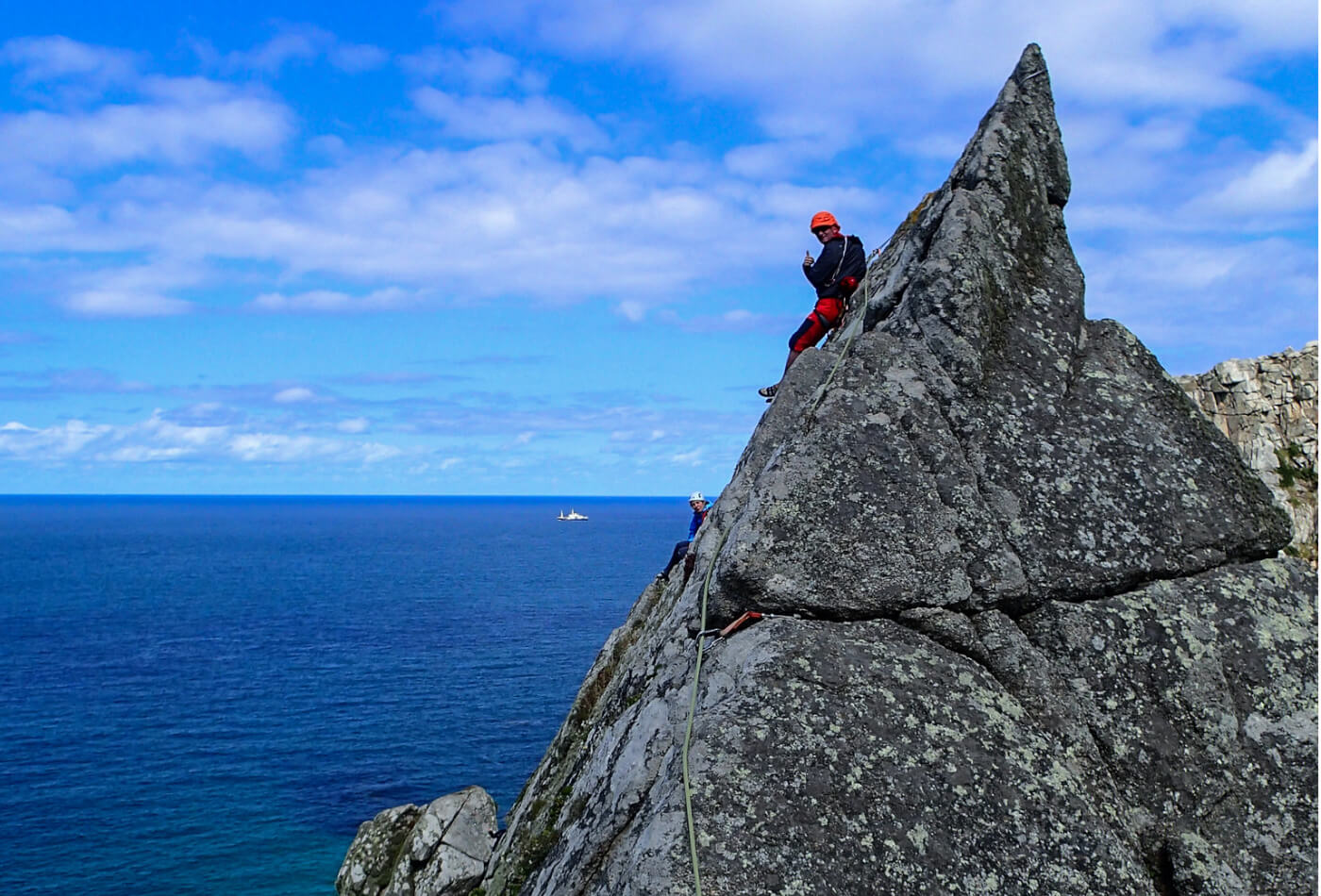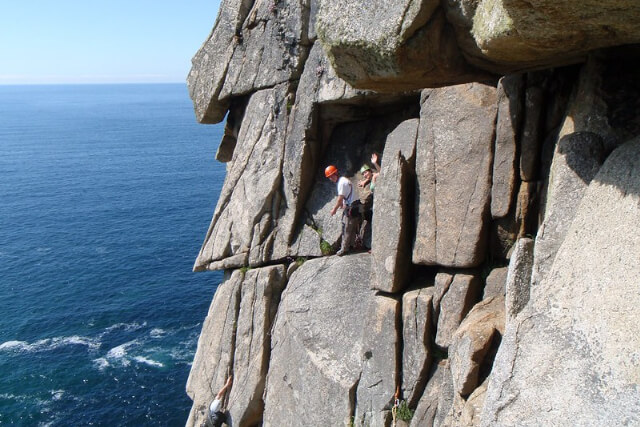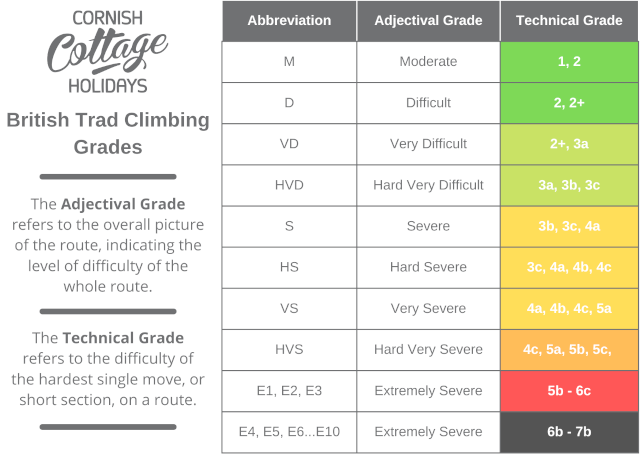New Year’s Day in Cornwall
Who can imagine a better way to spend New Year’s Day than in the crisp sunny outdoor air in...

Experience true adventure: go rock climbing in Cornwall!
Whether practiced indoors or outdoors, rock climbing is a great sport and activity. It’s a test of physical strength, coordination, intelligence and endurance.
Each climb is its own challenge, requiring forethought for every foothold and grip.
In this guide, we’ve compiled a list of the best places to go climbing in Cornwall, along with quick guide on types of climbing, traditional climbing grades, and where to go indoor climbing in Cornwall.
Read on to discover why you should go climbing in Cornwall…
Use these quick links to jump to a different section:

Cornwall is a dream for climbers. Over 300 miles of coastline, a microclimate, and plenty of relaxing places to kick back after a day on the rocks. What more could you ask for?
The popular and well-traversed sea cliffs on the West Penwith and southern coastline offer dramatic rock climbing in Cornwall. Picture frothing waves crashing against the granite below, while the sun beats down on the cliff face. Enjoy picnics and barbecues on the beach after a day of climbing, or maybe a casual post-climb surf.
Climbing in Cornwall isn’t just idyllic seascapes and coastal scenery though. Similar to the Dartmoor tor selection, Bodmin Moor is home to a good range of tors and quarries worth tackling. The Cheesewring and Carn Brea Quarry are popular locations for rock climbing and bouldering in Cornwall.
When the weather isn’t ideal, there’s a handful of places to go indoor climbing in Cornwall too. Indoor climbing is also an ideal place to start for beginners, especially with many climbing centres offering tuition and lessons.
View this post on Instagram
Located in West Cornwall in West Penwith is this popular Cornwall climbing spot. Bosigran is a large granite sea cliff perched high above a boulder-strewn cove.
There are several areas of the cliff that you can climb. These include The Main Cliff, The Seaward Cliff, Bosigran Ridge a.k.a Commando Ridge, and Great Zawn.
These coastal Cornwall climbing spots at Bosigran are tide-less, so you don’t have to worry about checking the tide times.
It’s also a great climbing spot for varying abilities; from experts to beginners. Although if you are new to climbing, make sure you have a more experienced climbing partner with you.
Popular route: Alison Rib (D)
View this post on Instagram
Chair Ladder is another exposed granite sea cliff in West Penwith. The start of the routes at Chair Ladder are only accessible for 3 hours either side of low tide in calm seas, so it does require some careful planning around the tides.
The base of the cliff is very exposed to the elements, although the rock does quickly dry as the cliff gets plenty of sun.
The popular areas here include Zawn Rinny, Ash Can Gully, and Pinnacle Gully. It’s worth noting that there is a seasonal restriction on this route from 15 March to 30 June due to nesting birds.
Terrier’s Tooth (HS 4b) is a popular route choice, and takes you out onto an exposed slab with the sea crashing below.
Popular route: Overhanging Chimney (VS 4c)
View this post on Instagram
The Cheesewring is one of the major inland locations for climbing in Cornwall. Located on Bodmin Moor, it is the largest crag in central Cornwall.
The Main Face is 36 metres high at its highest point. The quarry is known for its bold routes due to the nature of the quarried granite. Some of the routes can be very technical.
However, there are plenty of lower grade routes to try out in the surrounding area. Bodmin Moor’s tors are similar to those on Dartmoor, offering a range of mid-grade trad routes, such as Roche Rock.
Popular route: Simanon Direct (HVS 4c)
View this post on Instagram
Climbing in Sennen is akin to climbing in the Mediterranean, especially in summer. Sennen is home to quality climbing routes with excellent holds thanks to the granite cliff face.
This makes it a prime Cornwall climbing location for less experienced climbers. The most popular route is Demo Route (HS 4b), with more difficult routes including 29 Palms (E8 6c) and Tears of a Clown (E7 6b).
Sennen only has one tidal section; the Black Zawn, which is sea-washed at high tides and can be very dangerous during rough seas.
Popular route: Demo Route (HS 4b)
View this post on Instagram
Up in North Cornwall near Polzeath is Pentire Head. This beautiful headland on the Atlantic Coast is home to a huge vertical wall that provides quality climbing terrain.
The Great Wall, as it is known, is capped by steep slim corners and offers up a mix of cracks, slabs and overhangs.
It’s main four routes are Eroica (E4 6a), Black Magic (E5 6a), Darkenbad the Brightdayler (E5 6a), Wall of Spirits (E8 6b) and Siren’s Cry (E6 6a). The last three routes are not for the faint-hearted, whilst Eroica is one of the UK’s most illustrious sea-cliff challenges.
Experienced climbers practice the more extreme side of the sport.
Popular route: Eroica (E4 6a)
View this post on Instagram
Just around the corner from Port Quin and Port Isaac is Doyden Point. There are several routes to choose from here, including Flying Circus (E2 5c), Caprice (VS 4c), Lotus (E1 5b) and Yogic Flyer (E5 6a).
The cliff face enjoys a sunny outlook and is not tidal; however, it should be avoided in rough seas.
Popular route: Caprice (VS 4c)
View this post on Instagram
Trewavas Head offers some of the most accessible and enjoyable climbing in Cornwall. This climbing spot is located on the South Cornwall coast, between Praa Sands and Porthleven.
Trewavas is granite, although it’s finer-grained than the West Penwith cliffs. There’s several areas to climb, including Trewavas Head, Trewacas Main Cliff, West and East Crag.
Popular route: The Tower (D)
Sometimes the weather isn’t always on your side. Or you simply want a safer spot to practice your skills, with plenty of supportive staff around to offer help and advice.
There’s lots of places to go indoor climbing in Cornwall. As Cornwall is a popular region for climbing, it makes sense that there’s a good number of indoor climbing hubs where you can hone your overhangs and practice holds.

Trad (traditional) climbing involves placing pieces of gear into faults in the rock to secure your rope to as you ascend the climb. This means that should the climber fall, the gear they have placed in the rock should hold them and their partner below will catch their fall on the rope.
When lead climbing, you climb with a rope, and clip the rope into bolts that are already drilled into the rock as you go. Climbers have quickdraws (two carabiners connected by a length of webbing) attached to their harness, so they can clip one side to the bolt and the other to the rope.
In top roping, the climber is secured by a rope attached to an anchor already set up at the top of the route. It’s one of the safest ways to enjoy climbing and is ideal for beginners.
Bouldering does not involve any harnesses or ropes. You simply need a pair of climbing shoes, a bag of chalk, and a safety mat. Bouldering involves tackling bouldering ‘problems’ (i.e. routes or a sequence of moves) to get from A to B.
This one is pretty simple! Speed climbing is climbing a route as fast as possible. It can be done individually or as part of a team.
This type of free climbing involves no climbing aids or protection from ropes. It’s an extremely dangerous form of climbing as there is nothing to catch your fall. Free soloing has been pioneered by Alex Hannold, who famously free soloed the 884-metre route, El Capitan, in 3 hours and 56 minutes.
We hope this has helped towards introducing you to the wonder of Cornwall’s climbing scene!
This blog is intended for information purposes only, and is not an instruction manual.
Please always remember, rock climbing is a dangerous sport and should be treated as such.
Seek guidance, support and advice from climbing professionals before attempting these routes and always climb with a partner if you are new to climbing.
Happy safe climbing!
If you’re feeling inspired to get out on a climbing adventure, browse our many Cornwall cottages for your accommodation.
For more inspiration, check out these unusual things to do in Cornwall, or the best walks in Cornwall.